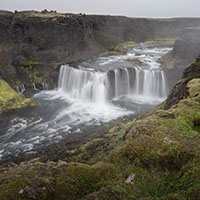How to capture sharp landscape images from front to back
posted Tuesday, July 20, 2021 at 6:00 AM EDT

Capturing landscape images that are sharp from front to back is challenging. There are multiple ways to achieve visible detail throughout your entire image, and each method has pros and cons. In many cases, it's not as simple as just stopping down the lens to increase your depth of field.
In a new video, photographer Nigel Danson takes us with him on location in Iceland to show how he gets pin-sharp photos from front to back. As he points out, focus and depth of field are critical components of a sharp image. Choosing where to focus within a scene impacts the visible sharpness of your shot, especially within the context of hyperfocal distance. What is hyperfocal distance? As Danson puts it, it's 'the closest point at which the furthest away that is in focus.' It's important to emphasize that 'in focus' doesn't mean that it's tack sharp, but rather that it's acceptably sharp.
Danson doesn't think about hyperfocal distance all that often. Instead, he thinks about depth of field nearly all the time. For the beginners among us, depth of field is how much in front of and behind the focal plane is in focus. For example, at a given focal length and aperture, let's say 35mm and f/2.8, some of the area in front of and behind your subject will appear visibly sharp. That area is the depth of field. All else equal, if you stop down the lens to f/8, the depth of field will increase, and that sharp area in front of and behind your subject will expand, which is typically what you want in a landscape image.
What else impacts the depth of field? Your camera's sensor size (bigger sensors result in shallower depth of field), focal length (longer focal length means shallower depth of field), where you focus (if you focus closer, depth of field is shallower) and aperture (a wider aperture delivers a shallower depth of field). Understanding these variables will allow you to set up your camera and lens to capture sharper images with greater depth of field. You can also use smartphone apps to help you understand the depth of field for a given camera, lens and focus distance combination. Danson discusses and uses the app, PhotoPills, in his video.
In some cases, a given scene cannot be captured sharply from front to back in a single shot, no matter what you do. In this case, a technique called focus stacking will help. Focus stacking involves capturing multiple images that are identical save for your focus distance. By capturing images with different focus distances in a series, you can combine the shots on your computer to retain only the sharpest areas from each shot. The final composite can be extremely sharp, from a very close object to infinity. In the video above, Danson discusses when you need to focus stack and how to set up your camera for the technique.
As you spend more time in the field thinking about depth of field, it will become easier to understand the demands of different scenes. When trying to capture a sharp image, a photo where every part of the scene is located far away is very different in terms of required settings than a photo in which you have some objects very close to the camera and other objects way off in the distance. Danson runs through various situations in his video, showing how he thinks about the depth of field in different landscape photography scenarios.
To see more of Nigel Danson's work, visit his website and follow him on Instagram. For more behind-the-scenes footage and tutorial videos, visit Danson's YouTube channel.
(Via Nigel Danson)